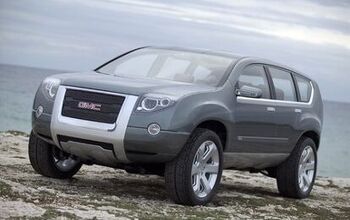General Motors Death Watch 149: Contractual Obligations
After perusing the United Auto Workers’ (UAW) contract with GM, I reckon both sides got a good deal. The UAW secured job guarantees: assurances that GM won’t off-shore new and existing products for the North American market. For its part, The General gets to off-load the lion’s share of its fixed costs AND a chance to lower the pay scale for a third of its hourly workforce. If the contract is ratified, the UAW protects its existing members’ livelihoods and GM becomes a lower-cost producer. No question: it’s a new lease on life.
By removing The Mother of All Fixed Costs (retiree health care), GM will have the chance to do something it couldn’t do for decades: stop making cars. That may sound like the very definition of a Pyrrhic victory, but GM’s always-on product spigot has been the bane of its existence. Sure, it generated cash to pay the hired help's health care, but it also created a tsunami of new product. The flood drove down new car prices, lowered used car residuals and dragged all eight GM brands (including Cadillac) into K-Mart country.
Under the new contract, GM can throttle back factory output to more closely match supply with demand. With careful husbandry, residual values of used GM vehicles will rise. Even better, with all that slop drained from the system, GM can (at least in theory) make greater profits on lower volumes, or lower prices further to gain market share, or add content, or some combination thereof. What was once a desperate struggle to sell whatever came out the factory gates suddenly becomes a more considered battle to meet or beat the competition.
Actually, this has always been CEO Rick Wagoner’s turnaround plan: cut costs until they match production and then build the business back up from there. And a damn fine plan it was too, back in ’05; back when GM’s US market share stood at 26.2 percent. And it was still a pretty good idea the next year, when GM’s market share sank to 24.7 percent. And you gotta love it today, when GM’s market share has tumbled to 22.1 percent. The question is, how low can GM go?
The short answer: another three or four percentage points of US market share. If GM production drops below that level– 12 percent or 500k units in production terms– the business will rapidly become unsustainable.
Prior to '05, GM has been shedding four percent US market share roughly every six years. The company lost that much ground from 1991 (35 percent) to 1997 (31.3 percent); and from 2000 (28.2 percent) to 2006 (24.7 percent). But those were good years for the US car industry. Considering the four percent hit since '05 and today’s contracting new car market, it's easy to imagine that timeline could contract violently. And then it’s lights out.
I repeat: all the cost savings won’t be enough if GM’s North American profits continue to fall faster than its savings– which is what’s happening now. Yes, GM’s sold its remaining "non core" assets and put together a nice little $32b nest egg. Even after deducting $5b to $6b to pay for the new health care VEBA (the remainder involves a transfer of existing VEBA control from GM to the UAW), that still leaves the automaker plenty of time to lose plenty of money. But postponing defeat is not the same as assuring victory.
The new UAW contract could be a genuine "get out of jail free" card, but GM still can’t cut their way to prosperity. That’s the mantra pundits chanted two years ago, when Rick Wagoner announced the first “historic health care giveback” (a.k.a. a $3b GM-funded health care VEBA). It’s just as true now, with a $29.9b union-controlled health care VEBA in the works. Until and unless GM recaptures lost ground in the sales charts, or at least holds steady, the company is on a downwards trajectory, spiraling into the abyss.
Course correction requires reversing a 17-year trend. With eight brands and 7100 dealers selling some 65 models, what are the chances GM has the focus it needs to reignite vehicle sales across the board? Has GM’s management team learned their lessons re: badge engineering, brand positioning, customer service, product quality and long-term marketing? Are they now ready to put in the long, hard slog needed to gradually and steadily improve their existing products, rather than swinging for the fences with Hail Mary newbies like, dare I say it, the Chevrolet Volt?
Dream on. If anything, this bold UAW contract will create a new sense of complacency, as both union and management congratulate and [generously] reward themselves for pulling back from the brink of disaster. Whatever brave plans GM has for its future, its stultifying bureaucracy will, as always, have the last word.
More by Robert Farago
Latest Car Reviews
Read moreLatest Product Reviews
Read moreRecent Comments
- Varezhka Maybe the volume was not big enough to really matter anyways, but losing a “passenger car” for a mostly “light truck” line-up should help Subaru with their CAFE numbers too.
- Varezhka For this category my car of choice would be the CX-50. But between the two cars listed I’d select the RAV4 over CR-V. I’ve always preferred NA over small turbos and for hybrids THS’ longer history shows in its refinement.
- AZFelix I would suggest a variation on the 'fcuk, marry, kill' game using 'track, buy, lease' with three similar automotive selections.
- Formula m For the gas versions I like the Honda CRV. Haven’t driven the hybrids yet.
- SCE to AUX All that lift makes for an easy rollover of your $70k truck.


































Comments
Join the conversation
I have to say I'm really suprised that this does seem like a good deal for both sides. I didn't anticipate the $20B VEBA account to already be in existence. Didn't I hear they had ~$50B unfunded health care liability? Obviously it could have been better, but this has to be the best compromise between the UAW and GM ever. GM does also deserves credit for managing the crisis layed out by SherbornSean. Now all they have to do is focus on the products!
GM's main problem seems to be they have competition. If not for customers having a choice to buy something else, they would be in fat city. The one thing no contract or labor agreement can ever address is the customer and his money. It is the oil the engine runs on and they are 2 quarts low at least. This requires a total attitude adjustment from the top down, and that is not forthcoming.